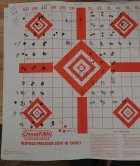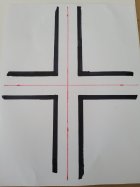You might want to take a look at Erik Cortina's load development method for your charge weight testing:
Yes, 82.77 is what I would go with.
forum.accurateshooter.com
Although the thread is 113 pages long, you need only go through the first few pages for the methodology itself. The rest is largely devoted to people's test target and discussion about them, which can also be very useful as examples.
Erik's method is simple, straightforward, only requires a 100 yd range, and it works. This method of testing is also referred to an an "Optimal Charge Weight", or "OCW" test. You can do a search for Dan Newberry OCW Test. In a nutshell, the centerpoint of groups fired with [incrementally] increasing charge weight will move around in relation to the point of aim (POI). You're looking for a charge weight window of at least two to three (or more) groups representing
successive charge weight increments where the centerpoint of each group has the same position relative to the POI. What that really means is a charge weight window across which the barrel harmonics/timing remain relatively constant as charge weight increases; i.e. relatively stable. By inference, a charge weight selected from the middle of this window would also be stable and therefore resistant to temperature-induce velocity changes. Although many find having velocity/chronograph data a valuable addition to this test, it is not absolutely essential. Movement of the group centerpoints about the POI (i.e. the target itself) are all you need to interpret the results of the test. You can also post the target in Erik's thread to get plenty of feedback and/or suggestions.
Information your initial post lacks is the cartridge/powder/bullet combination with which you will be working. It might be beneficial to add that information. Your seating depth testing approach should work as is, but you might wish to use a different increment than .002", at least initially, so you can cover a wider seating depth window with fewer loaded rounds. The use of .003" is common, or you might even try a preliminary seating depth test using .005" increments. However, .005" is a very coarse increment and it is possible to miss things on occasion. Likewise, 0.1 gr is a very fine charge weight increment. It is rare, although not unheard of, to find reloaders using a smaller charge weight increment than 0.1 gr in a charge weight test. My point here is that by providing the specific cartridge/bullet/powder combination you intend to test, it may be possible to obtain better feedback from members that may have developed similar loads on the relative size of charge weight and seating depth increments to use in your testing. It may also provide useful information on about where you might expect your load to tune in.
Finally, I would suggest that if you can find someone in your area that is an experienced reloader to help you as you get started, it will be of significant benefit. The process can seem daunting at first, and having someone available to answer questions verbally can be very useful.












